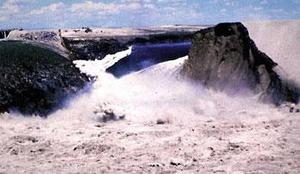Infrastructure protectionVirginia quake highlights overlooked danger: decrepit dams
Tuesday’s Virginia earthquake raised fears that a Fukushima scenario would unfold somewhere on the East Coast, but experts say that earthquake pose a much greater threat: breaching decrepit dams; of the 85,000 dams in the United States, 4,000 are seriously unsafe or deficient — and of those, 1,800 are located in areas where a breach would cause grave damage to life and property

Concerns about dam failures come to the fore // Source: qwiki.com
Tuesday’s Virginia-centered earthquake, which shook the East Coast of the United States, caused a nuclear power plant in Virginia to be immediately taken off line, and for its cooling system to be powered by back-up generators.
Many may have feared the tremor may bring about a Fukushima-like disaster, but Scientific American notes that Americans should be more worried about a quieter danger: tens of thousands of dams, many built before seismic engineering came of age, have the potential to release tsunami-like flash floods in the event of a seismic breach.
In 2009 the American Society of Civil Engineers released a survey of the state of infrastructure in the United States. The group found that dams are, in terrible disrepair. Of the more than 85,000 dams in the United States, more than 4,000 are unsafe or deficient, and nearly 1,800 of those are located in areas where a breach would cause serious damage to life and property. SciAm notes that With so many dams in state of disrepair, it is difficult to decide which dam poses the greatest threat.
What is more, the budget for dam inspectors is . Texas, for example, employs just seven inspectors to keep an eye on 7,400 dams, and in many states inspectors lack the authority to inspect private dams, including those built to hold back the chemical by-products of mining operations.
There are other problems with dams. SciAm reports that in the past, engineers often built dams using a slurry of soil and water that would eventually settle into place. An earthquake, however, might liquefy the core of the dam. Although these dams were most often built in locations that were not thought to suffer from earthquakes, Tuesday’s Virginia earthquake shows earthquakes may no longer limited to the west coast. “New York City wasn’t supposed to be seismic 20 or 30 years ago,” Tarek Abdoun, a civil engineer at Rensselaer Polytechnic Institute, told SciAm, “but the standard for what should require seismic loading has changed.”
The Association of State Dam Safety Officials estimates that $50 billion would be needed to repair all the U.S. faulty dams. “Until that money comes through, fragile nuclear reactors should not be our only worry,” SciAm concludes.
